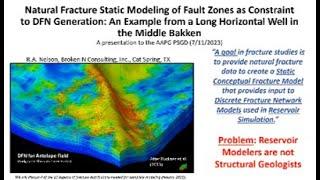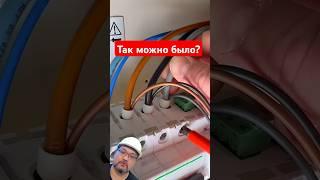
AAPG PSGS: Natural Fracture Static Modeling of Fault Zones as a Constraint to DFN by Ron Nelson
AAPG PSGS July Webinar
Natural Fracture Static Modeling of Fault Zones as Constraint to DFN Generation: An Example from a Long Horizontal Well in the Middle Bakken
Presented by Dr. Ron A. Nelson
Broken N Consulting, Inc., Cat Spring, TX
Abstract:
Structural Geologists are often focused on natural fracture description in surface and subsurface studies to develop static models of natural fracture distributions in reservoirs. The aim of the Static Conceptual Fracture Model (SCFM) is to constrain development of a Discrete Fracture Network model (DFN) for use in Reservoir Simulation, or predictions of fluid flow and recovery behavior with time, see Nelson (2020).
An important aspect of the SCFM is the distribution of fractures and deformation associated with faults within the reservoir to be simulated. This presentation will highlight a particular example of subsurface fracture data collection from a 9,000’ horizontal well in the Bakken Reservoir with a full length interpreted horizontal image log with an accompanying horizontal core. Analysis shows the presence of 6 intercepted faults of the same fault type and fracture orientation. In addition, fracture zones surrounding the faults and deformation at the slip surfaces are defined quantitatively, as well as fracture intensity decay rates away from the fault surfaces.
These results contribute in an important way to the quantitative database of the SCFM and eventual DFN. These results are, however, only a piece of the needed database that includes other modeling aspects such as;
Background fracture orientation and intensity away from the faults,
Fracture intensity and orientation of other types of fractures within the reservoir, such as Regional Fractures, Diagenetic Fractures, and Fold Related Fractures,
Morphology and fluid flow aperture of the fracture planes present by type of fracture.
Bio:
Ron has 3 degrees in Geology: a BS degree in Invertebrate Paleontology from Northern Illinois Univ., an MS degree in Igneous and Trace Element Geochemistry and a PhD in Structural Geology and Rock Mechanics, both from Texas A&M University. He worked for Amoco and later BP for 25 years in various technical and managerial positions, including serving as the first Supervisor of Amoco’s Structural Geology Research Group. Since leaving the companies, he started Broken N Consulting and has done consulting on structural geology and fractured reservoirs for 22 years serving 51 different clients world-wide. Ron has authored 121 publications including 3 textbooks on fractured reservoir analysis, one that won the PSGD award for Best Seminal Publication in 2018.
His career has spanned from early work on qualitative assessment of reservoir fracture systems in core and outcrop to quantitative description of fracture system from image logs and fluid flow to support numerical modeling of reservoir behavior with time. His work has always sought to merge geological, engineering, rock mechanics and geophysical approaches to solve fracture behavior in subsurface reservoirs.
Natural Fracture Static Modeling of Fault Zones as Constraint to DFN Generation: An Example from a Long Horizontal Well in the Middle Bakken
Presented by Dr. Ron A. Nelson
Broken N Consulting, Inc., Cat Spring, TX
Abstract:
Structural Geologists are often focused on natural fracture description in surface and subsurface studies to develop static models of natural fracture distributions in reservoirs. The aim of the Static Conceptual Fracture Model (SCFM) is to constrain development of a Discrete Fracture Network model (DFN) for use in Reservoir Simulation, or predictions of fluid flow and recovery behavior with time, see Nelson (2020).
An important aspect of the SCFM is the distribution of fractures and deformation associated with faults within the reservoir to be simulated. This presentation will highlight a particular example of subsurface fracture data collection from a 9,000’ horizontal well in the Bakken Reservoir with a full length interpreted horizontal image log with an accompanying horizontal core. Analysis shows the presence of 6 intercepted faults of the same fault type and fracture orientation. In addition, fracture zones surrounding the faults and deformation at the slip surfaces are defined quantitatively, as well as fracture intensity decay rates away from the fault surfaces.
These results contribute in an important way to the quantitative database of the SCFM and eventual DFN. These results are, however, only a piece of the needed database that includes other modeling aspects such as;
Background fracture orientation and intensity away from the faults,
Fracture intensity and orientation of other types of fractures within the reservoir, such as Regional Fractures, Diagenetic Fractures, and Fold Related Fractures,
Morphology and fluid flow aperture of the fracture planes present by type of fracture.
Bio:
Ron has 3 degrees in Geology: a BS degree in Invertebrate Paleontology from Northern Illinois Univ., an MS degree in Igneous and Trace Element Geochemistry and a PhD in Structural Geology and Rock Mechanics, both from Texas A&M University. He worked for Amoco and later BP for 25 years in various technical and managerial positions, including serving as the first Supervisor of Amoco’s Structural Geology Research Group. Since leaving the companies, he started Broken N Consulting and has done consulting on structural geology and fractured reservoirs for 22 years serving 51 different clients world-wide. Ron has authored 121 publications including 3 textbooks on fractured reservoir analysis, one that won the PSGD award for Best Seminal Publication in 2018.
His career has spanned from early work on qualitative assessment of reservoir fracture systems in core and outcrop to quantitative description of fracture system from image logs and fluid flow to support numerical modeling of reservoir behavior with time. His work has always sought to merge geological, engineering, rock mechanics and geophysical approaches to solve fracture behavior in subsurface reservoirs.
Комментарии:
AAPG PSGS: Natural Fracture Static Modeling of Fault Zones as a Constraint to DFN by Ron Nelson
AAPG Petroleum Structure and Geomechanics Division
Fallout 3 Tall Tale
ourlordleviathan
КАК сделать плавающую/прилипающую шапку (или меню)?
Просто: разработка
Nach dem Beat schneiden in der CapCut App
Tutorials for you
СЕКРЕТНА ІНФА ПРО ВІДЕО #YASHKINA
#YASHKINA
a week in my life of an IB student
revisign
unable to set upi pin problem in phone pe telugu||phone pe Upi pin not set problem telugu
Moonstar Tech Entertainment
Bright - SINA (Official Music Video)
Bright Tz


























